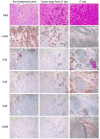Safety and Efficacy of Intratumoral Injections of Chimeric Antigen Receptor (CAR) T Cells in Metastatic Breast Cancer
- PMID: 29109077
- PMCID: PMC5712264
- DOI: 10.1158/2326-6066.CIR-17-0189
Safety and Efficacy of Intratumoral Injections of Chimeric Antigen Receptor (CAR) T Cells in Metastatic Breast Cancer
Abstract
Chimeric antigen receptors (CAR) are synthetic molecules that provide new specificities to T cells. Although successful in treatment of hematologic malignancies, CAR T cells are ineffective for solid tumors to date. We found that the cell-surface molecule c-Met was expressed in ∼50% of breast tumors, prompting the construction of a CAR T cell specific for c-Met, which halted tumor growth in immune-incompetent mice with tumor xenografts. We then evaluated the safety and feasibility of treating metastatic breast cancer with intratumoral administration of mRNA-transfected c-Met-CAR T cells in a phase 0 clinical trial (NCT01837602). Introducing the CAR construct via mRNA ensured safety by limiting the nontumor cell effects (on-target/off-tumor) of targeting c-Met. Patients with metastatic breast cancer with accessible cutaneous or lymph node metastases received a single intratumoral injection of 3 × 107 or 3 × 108 cells. CAR T mRNA was detectable in peripheral blood and in the injected tumor tissues after intratumoral injection in 2 and 4 patients, respectively. mRNA c-Met-CAR T cell injections were well tolerated, as none of the patients had study drug-related adverse effects greater than grade 1. Tumors treated with intratumoral injected mRNA c-Met-CAR T cells were excised and analyzed by immunohistochemistry, revealing extensive tumor necrosis at the injection site, cellular debris, loss of c-Met immunoreactivity, all surrounded by macrophages at the leading edges and within necrotic zones. We conclude that intratumoral injections of mRNA c-Met-CAR T cells are well tolerated and evoke an inflammatory response within tumors. Cancer Immunol Res; 5(12); 1152-61. ©2017 AACR.
©2017 American Association for Cancer Research.
Conflict of interest statement
The University of Pennsylvania has a strategic alliance with Novartis for the development of chimeric antigen receptors. This arrangement is managed in accordance with the University of Pennsylvania’s Conflict of Interest Policy. The authors are in compliance with this policy. Y.Z., B.L.L, and C.H.J. are co-founders of Tmunity Therapeutics.
Figures



Similar articles
-
Regional Delivery of Chimeric Antigen Receptor-Engineered T Cells Effectively Targets HER2+ Breast Cancer Metastasis to the Brain.Clin Cancer Res. 2018 Jan 1;24(1):95-105. doi: 10.1158/1078-0432.CCR-17-2041. Epub 2017 Oct 23. Clin Cancer Res. 2018. PMID: 29061641 Free PMC article.
-
Tumor Antigen and Receptor Densities Regulate Efficacy of a Chimeric Antigen Receptor Targeting Anaplastic Lymphoma Kinase.Mol Ther. 2017 Sep 6;25(9):2189-2201. doi: 10.1016/j.ymthe.2017.06.008. Epub 2017 Jul 1. Mol Ther. 2017. PMID: 28676342 Free PMC article.
-
Enhanced Cancer Immunotherapy by Chimeric Antigen Receptor-Modified T Cells Engineered to Secrete Checkpoint Inhibitors.Clin Cancer Res. 2017 Nov 15;23(22):6982-6992. doi: 10.1158/1078-0432.CCR-17-0867. Epub 2017 Sep 14. Clin Cancer Res. 2017. PMID: 28912137
-
In Vitro-Transcribed mRNA Chimeric Antigen Receptor T Cell (IVT mRNA CAR T) Therapy in Hematologic and Solid Tumor Management: A Preclinical Update.Int J Mol Sci. 2020 Sep 6;21(18):6514. doi: 10.3390/ijms21186514. Int J Mol Sci. 2020. PMID: 32899932 Free PMC article. Review.
-
Hurdles of CAR-T cell-based cancer immunotherapy directed against solid tumors.Sci China Life Sci. 2016 Apr;59(4):340-8. doi: 10.1007/s11427-016-5027-4. Epub 2016 Mar 11. Sci China Life Sci. 2016. PMID: 26965525 Review.
Cited by
-
Immunotherapeutic Agents for Intratumoral Immunotherapy.Vaccines (Basel). 2023 Nov 14;11(11):1717. doi: 10.3390/vaccines11111717. Vaccines (Basel). 2023. PMID: 38006049 Free PMC article. Review.
-
mRNA therapeutics: New vaccination and beyond.Fundam Res. 2023 Mar 16;3(5):749-759. doi: 10.1016/j.fmre.2023.02.022. eCollection 2023 Sep. Fundam Res. 2023. PMID: 38933291 Free PMC article. Review.
-
The efficacy and applicability of chimeric antigen receptor (CAR) T cell-based regimens for primary bone tumors: A comprehensive review of current evidence.J Bone Oncol. 2024 Sep 22;48:100635. doi: 10.1016/j.jbo.2024.100635. eCollection 2024 Oct. J Bone Oncol. 2024. PMID: 39381633 Free PMC article. Review.
-
Current Clinical Evidence and Potential Solutions to Increase Benefit of CAR T-Cell Therapy for Patients with Solid Tumors.Oncoimmunology. 2020 Jun 10;9(1):1777064. doi: 10.1080/2162402X.2020.1777064. Oncoimmunology. 2020. PMID: 32934880 Free PMC article. Review.
-
The Great War of Today: Modifications of CAR-T Cells to Effectively Combat Malignancies.Cancers (Basel). 2020 Jul 24;12(8):2030. doi: 10.3390/cancers12082030. Cancers (Basel). 2020. PMID: 32722109 Free PMC article. Review.
References
-
- Porter DL, Hwang W-T, Frey NV, Lacey SF, Shaw PA, Loren AW, Bagg A, Marcucci KT, Shen A, Gonzalez V, Ambrose D, Grupp SA, Chew A, Zheng Z, Milone MC, Levine BL, Melenhorst JJ, June CH. Chimeric antigen receptor T cells persist and induce sustained remissions in relapsed refractory chronic lymphocytic leukemia. Sci Transl Med. 2015;7:303ra139. doi: 10.1126/scitranslmed.aac5415. - DOI - PMC - PubMed
-
- Bottaro DP, Rubin JS, Faletto DL, Chan AM, Kmiecik TE, Vande Woude GF, Aaronson SA. Identification of the hepatocyte growth factor receptor as the c-met proto-oncogene product. Science. 1991;251:802–4. - PubMed
Publication types
MeSH terms
Substances
Grants and funding
LinkOut - more resources
Full Text Sources
Other Literature Sources
Medical
Miscellaneous

